Chinese exports grew strongly in July, rising 14.5 percent year-over-year and an impressive 8.2 percent month-over-month, seasonally adjusted. That increase pushed the sequential trend growth rate — three months over three months, seasonally adjusted annual rate — to its highest level since early 2011 (see chart 1).
China exports and imports (%3m/3m, saar)
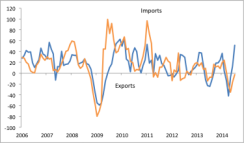
Source: JPMSL; data through July 2014
Several caveats apply to these figures. First, volatility characterizes this series, with surges that can be followed by plunges, often generated by difficulty in properly adjusting for Chinese New Year effects. Second, misreporting appears to have characterized Chinese export data in the past few years, and the July number shows some signs of having been inflated by the inclusion of fake shipments. Third, import growth has lagged recently, despite generally solid domestic demand, a possible harbinger of near-term weakness in exports (as a significant portion of imports relates to future production for sale abroad). Nonetheless, it seems likely that Chinese exports have genuinely strengthened, at least to some degree.
The upturn in Chinese exports represents an encouraging signal for the rest of emerging-markets Asia, where exports have broadly stagnated over the past year. Exports from emerging-markets Asia ex-China rose just 2.4 percent year-over-year in the three months to June. Although they had shown signs of sequential acceleration around the turn of the year, they have weakened more recently, dropping 2.7 percent, three months over three months, in June (see chart 2). With domestic demand in many emerging-markets economies feeling headwinds from tightening credit availability and weak corporate profitability, industrial production growth in emerging-markets Asia has struggled alongside exports (see chart 3).
EM Asia ex-China exports (%)
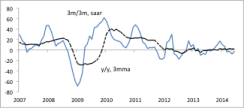
Source: JPMSL, JPMAM; data through June 2014
EM Asia ex-China exports and industrial production (% 3m/3m, saar)

Source: JPMSL, JPMAM; data through June 2014
What accounts for the poor performance of Asian exports? Of course, persistently weak growth in the developed world explains much of the disappointment. Developed-markets real gross domestic product expanded at an average annualized pace of just 1.2 percent between the start of 2012 and the first quarter of 2014. Even in this context, though, Asian exports have underperformed compared with prerecession norms. The global aggregate manufacturing purchasing managers’ index (PMI), for example, has lately occupied territory similar to that observed in 2006 and 2007. But Asian export growth has run at a noticeably softer rate (chart 4).
EM Asian exports (%y/y, 3mma) and global manufacturing PMI
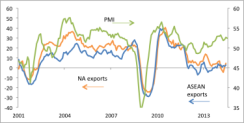
Source: JPMSL, JPMAM; data through July 2014
This shift likely reflects in part a change in the relationship between growth and trade flows, which are in turn related to the completion of the globalization process. In the U.S., for example, just before the 2008–’09 financial crisis, imports grew significantly faster than overall GDP, on average, in part because of the secular transfer of production to the emerging world. Following a bounce in the early phase of the expansion, import demand generally has run at a pace much closer to that of GDP during the past few years (see chart 5). The composition of growth may also have worked against emerging-markets Asia, with weak spending on consumer durables and certain capital goods and stronger demand for items less likely to be imported. On this front, the second quarter brought some encouragement, with U.S. imports picking up significantly and more strongly than overall growth.
US real GDP and real imports of goods (% q/q, saar)
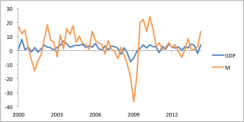
Source: JPMSL; data through 14Q2
At the same time, underneath aggregate figures, the structure of global growth probably has not helped. Exporters in emerging-markets Asia gained significant market share in Europe ahead of the recession, and weakness in that part of the world since 2011 has likely exercised a disproportionate effect on Asia (see chart 6). Meanwhile, the period of strong growth in Japan with the implementation of policy stimulus did not pass through into booming import demand because of the yen depreciation that the monetary shift engendered. More recently, the plunge in Japanese spending that followed the recent tax hike did not greatly affect global business confidence surveys but appears to have hit emerging-markets Asian exporters hard. In other words, the global backdrop likely has been effectively weaker for emerging-markets Asia than overall figures suggest.
Merchandise imports; (% 3m/3m; saar)

Source: JPMSL; JPMAM; data through May 2014
Another change in the global atmosphere in comparison with the precrisis era has also dampened emerging-markets Asian export growth at the margin. Large-scale spare capacity around the globe has resulted in very weak merchandise pricing, as evidenced by near-zero inflation rates for goods in most developed-markets economies. Positive inflation before 2008 meant that the nominal value of U.S. goods imports ran a bit ahead of volume growth (see chart 7). Now the two growth rates look very similar. A given level of real demand for emerging-markets Asian exports is therefore producing a slightly slower pace of nominal growth.
U.S. imports of goods (% q/q; saar)
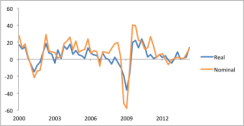
Source: JPMSL; data through 14Q2
Corporate investment spending on high-technology products has looked particularly weak since the recession. This factor may also be weighing on emerging-markets Asian exports, given these countries’ concentration in that area. Although there are various ways of defining high tech, by one measure U.S. imports of such items have not run at a disproportionately weak pace over the past few years (see chart 8). Overall economic weakness, rather than specific softness in technology, thus seems a more convincing explanation for emerging-markets Asian export malaise.
U.S. merchandise imports by type (% y/y, 3mma)
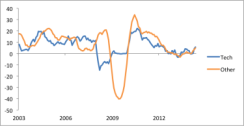
Source: JPMSL; JPMAM; data through May 2014
Much of the apparent shift in the relationship between developed-markets growth and imports looks structural in nature, meaning that emerging-markets Asian exports will struggle to regain their prerecession growth rates, except when the global economy is booming. The gradual normalization of the global economy, though, should produce growth that is better balanced, both in terms of composition and geographic breadth. These two factors will likely boost developed-markets import demand, to the benefit of emerging-markets Asia. Over time, global inflation will likely grind higher, giving emerging-markets Asian exporters a bit more pricing power. A new cycle of global tech investment could also help. In the near term, the end of Japan’s tax-induced slump should provide visible support. Emerging-markets Asian export growth thus will likely improve as the second half of 2014 continues to unfold, with further gains to occur gradually over the next few years.
Michael Hood is a market strategist for J.P. Morgan Asset Management. For additional Global Market Insights, please visit jpmorgan.com/institutional.
Get more on emerging markets.






